Though its protagonists would be loathe to admit it, the entire series of "Phonogram" bleeds nostalgia, no entry more nakedly so than "The Immaterial Girl." Issue #2 drops Emily into the plot of several iconic 80s music videos as she desperately tries to escape back to the real world and take back control of her body before Claire ruins everything she has built. Kieron Gillen's dialogue delivers his usual balance of clever one-liners and look-down-our-noses snark that established the series in the first place. McKelvie's clean, well designed art is as beautiful as expected as the artist expands the visual language of the book, pushing and challenging his own style with sequences like the action within the A-Ha's "Take On Me" universe.
Gillen uses nostalgia as a tentpole for this series, wrapping both sides of the narrative around it in order to explore its trappings and how it affects the future. Emily's concerns now lead her back down the path that took her to where she is; Gillen creates a literal sense of this by dropping the character into her past. Most characters in the series are a collection of their pop sensibilities and this issue is the equivalent of being sucked into one's own high school yearbook. The writer doesn't yet fall on a side of the argument as he escalates the action through to other music videos, including "Thriller" and "Material Girl." Each speaks to something in Emily, building blocks she took forward with her to create what she has now. They become bricks in a prison wall as she is chased down, threatened to be consumed by the videos she loves. McKelvie's forays into these worlds are a chance for him to play with his adept storytelling skills and superb design. The "Take On Me" sequence is the highlight as the characters look incredibly faithful to the iconic music video.
On the other end of the spectrum, Claire tries to dismantle everything Emily has in the present. To her, she was Emily's sacrifice at the altar, something left behind in order to create the future in her image. She enacts a scorched Earth policy for Emily's life, making like Ladytron and destroying everything she touches. They are two halves of the same whole desperately trying to establish dominance over each other instead of working together to create something bigger. Claire's manifestation of pain is extroverted while Emily's was always introverted, peeking out through her reviews and relationships with her subordinates.
The series bleeds style in both narrative and visuals, dropping references all over the place. McKelvie's use of 80s visuals, coupled with Matthew Wilson's complementary color art, embed the pages in a reader's mind. Gillen's scripting continues to toe the line ever closer to the sparse and clipped patterns of writers like Grant Morrison or Warren Ellis. Part of the fun of the series is unpacking the references stuffed into each issue and guessing against the reference guide in the back. Gillen also collaborates with Jamaica Dyer on a sweet backup strip as well, which is much more heartfelt than the meat of the issue.
Continuing towards what could be a huge climax, "Phonogram: The Immaterial Girl" #2 delivers to fans of the series. Though new readers would probably want to start with an earlier collection, they will quickly get wrapped up in the mysticism and fun of the best comic book about music on the stands.

